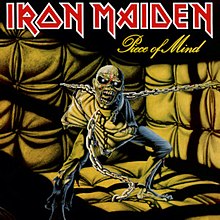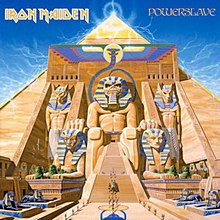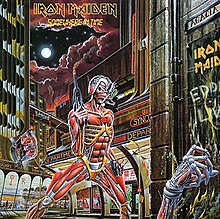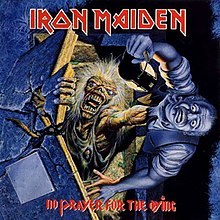Part Two: No prayer for the powerslaves, somewhere in time: Bruce Dickinson and global domination
After “Killers” Di'Anno was asked to leave the band due to various disputed reasons, and they hooked up with Bruce Dickinson, who had been singing with Samson. It was with him at the mike that they recorded their ultra-successful 1982 album, “The number of the Beast”, which shot straight to number one and is recommended as one of the “1001 albums you must hear before you die” in the book of the same name by Robert Dimery. The whole style of the album is different, perhaps due to songwriting being shared, perhaps due to the presence and charisma of Dickinson, or perhaps it was just a natural evolution of the band. But the overall feel of “The Beast” is of polished production, excellent songwriting, powerful and technically-proficient playing and indeed a band who are all on the same page. Possibly the conflicts with first Dennis Stratton and then Paul Di'Anno may have strained the atmosphere during the recording of the first two albums, but there is no such tension evident here.
Featuring songs like “22 Acacia Avenue” (subtitled “The continuing adventures of Charlotte the harlot”, who is seen in a song titled with her name on the first Maiden album), “The Prisoner”, for which the band had to gain permission from Patrick McGoohan to use audio clips from the cult TV series in the intro, and of course the two singles, “Run to the hills” and the title track, this was, in all ways possible, a monster album. “Run to the hills” shot to number seven in the charts, and is a powerful indictment of the treatment by the White Man of the Native Americans, featuring a killer guitar solo from Dave Murray and some singing which would earn Bruce his nickname of “Air-raid Siren”! The title track, and indeed the album title and artwork, earned Maiden the tag of Satanists, and true to form, the Religious Right in America sought to ban the sale of the album (and all Iron Maiden records, extended of course to other “questionable” metal bands), boycotted the gigs and burned their albums. What was that they said: “Where they burn books (or albums), they will later burn people.”

Laughing at this accusation, but nevertheless hurting from the adverse publicity and the boycotts of and protests at gigs, Steve Harris, as the face of the band, declared that far from being an anthem or prayer to the Devil, “The number of the Beast” was based on a nightmare he had after watching one of the Omen films, and the track even has a passage from the bible preceding it. But you can't tell the Moral Majority they've got it wrong, and the mud stuck.
Nevertheless, fans and heavy metal pundits alike loved the album, and it still stands as Iron Maiden's best. It also contains one of my own favourites from them, the epic “Hallowed be thy name”, which closes the album and runs to just over seven minutes. It tells the story of a man about to be hanged, and his thoughts as they lead him out to the gallows. It's quite an introspective piece for such a heavy song, starting off with doomy church bells (actually referred to in the lyric when he says
”I'm waiting in my cold cell/ When the bells begin to chime.”) and featuring some great guitar work from both Adrian Smith and Dave Murray.
For the next decade Iron Maiden were prolific in their releases, a new album usually being no more than two years from the previous. In between they of course toured extensively and released some live albums, of which “Live after death”, released in 1984, is regarded as their best. 1983 however saw the emergence of their fourth studio album, “Piece of mind”, with the obvious play on words in the title. It features this time Eddie in a straitjacket and imprisoned in a “rubber room”, with part of his brain missing, ergo the title. Despite the obvious imagery of madness, however, the album did not deal with the subject of insanity: rather, the songs were mostly influenced by or about books or films the lads enjoyed.

“Piece of mind” was the first album to feature new drummer Nicko McBrain, ex-Trust, who is still with Maiden to this day. It only featured two singles, but they were both very successful, just missing getting into the top ten. “The trooper” is a powerful, rollicking story of the Charge of the Light Brigade, while “Flight of Icarus”, with its heavy guitar intro, tells the legend of Icarus. Other good tracks on the album include “Die with your boots on”, “Where eagles dare” (based on the WWII movie) and “Sun and steel”, loosely based around the sword-and-sorcery heroes of fantasy literature like Conan and Kull. There's another epic on the album, again closing it, this time taking as its subject matter the Frank Herbert sci-fi series “Dune”. Called “To tame a land” it runs for nearly seven and a half minutes, and is again evidence of Maiden's dabbling in prog metal, towards which they were sliding closer with every album.
Only one year later and they released perhaps their most openly prog album to date, 1984's “Powerslave”. While it included “boys-own”-type adventures songs like “Aces high” and “Flash of the blade”, and a return to “The Prisoner” from “Number of the Beast” in the song “Back in the Village”, it was the two closing tracks that really characterised this album. The first being the title track, written from the point of view of an Egyptian god or pharaoh, and evidenced on the sleeve of the album with Eddie depicted as a huge stone statue like the Sphinx, being worshipped as a god. The lyric tells of the pharaoh/god's reluctance to give up life, as he moans
”Tell me why I have to be a powerslave?/ I don't wanna die/ I'm a god, why can't I live on?” but he realises at the song's conclusion that he has no more sway over life than the lowliest of his worshippers, as he accepts
”In my last hours I'm a slave/ To the power of death.” Not surprisingly, the music is eastern-tinged, to give the effect of being in Egypt.

The other standout track is their longest to date, the epic in every way “Rime of the Ancient Mariner”, based on the epic poem by Samuel Taylor Coleridge. It features a great bass solo halfway through that really gives the feeling of isolation and fear, and quotes much of the famous poem in the lyrics. There must have been some trepidation on the part of the band that metallers would listen to a song which runs to thirteen and a half minutes, and moreover, is based on a poem over a century and a half old, but it went down a storm thanks to the heavy riffs, powerful singing and, to be fair, gripping lyric, even if they were half-inched from the poem.
1986 and “Somewhere in time” hit the shelves. Different to previous albums, mostly due to the writing of Adrian Smith, it features more long compositions, like “The loneliness of the long-distance runner” (6:31), “Heaven can wait” (7:21) and the title track, “Caught somewhere in time” (7:26). In fact, the shortest track on the album is “Deja vu”, at 4:56, and even at 7:26 the title track is not the longest: that honour goes, once again, to the closer, this time called “Alexander the Great”, and clocking it at a massive 8:36! Again, despite the cover art depicting Eddie as a futuristic bounty-hunter/cyborg killer, the themes on the album range from madness to history to reflections on life. There are two sci-fi/future themed songs, in the title track and “Stranger in a strange land”, based on the novel by Robert A. Heinlein. With the comparitive lengths of the tracks, there end up only being eight in total.

You could I suppose say that this was also a very prog metal album, with its long compositions and its varied themes, and very few of the “rock till I drop” songs --- although even on their earlier recordings Maiden tended to eschew the generic metal themes like beer, women, fighting and who's the loudest. Some of these would find their way into later releases, though Maiden would more or less continue on the road towards total prog metal with each new album. “Somewhere in time” also pioneered their use of the guitar synth, belying a legend that had once appeared on the back cover of “Number of the Beast” --- “No synthesisers or ulterior motives”. With the move towards prog metal, it was perhaps inevitable that Iron Maiden would need to introduce some sort of keyboard sound, and this was how they went about it.
This culminated in what became the pinnacle of their progressive metal leanings, 1988's “Seventh son of a seventh son”, on which the guitar synths were swapped for actual keyboards, played by one Michael Kinney. This album also featured only eight tracks, although the longest, the title track, came in at just under ten minutes, with the next longest, “Infinite dreams”, a mere six minutes. The power and energy was still there, the great melodies and the hooks, and the interesting themes, though many of them were linked or semi-linked in a kind of a fairytale. Some of the better tracks on it, for me, are “Moonchild”, the title track, “The evil that men do” and “Only the good die young”. It's the first album since “Number” not to feature an epic closer, with “Only the good” clocking in at a mere 4:42.

It was also the last album to feature Adrian Smith, who left the band to return in 2000 for their triumphant “Brave new world”, an album I look on as their “comeback” album after years in the metal wilderness, of which more later. “Seventh son” also gave Maiden some of their highest-charting singles, with “Can I play with madness” going to number 3, the highest they had ever achieved.
Rather ironically, Smith had left the band because he was unhappy with the prog-metal direction Maiden were going in, but as soon as he left the next album, 1990's “No prayer for the dying” changed the musical direction and returned to a more hard-edged, rock/metal sound, with shorter songs and more of them. Despite the fact that it was panned by critics, it did yield Maiden their only ever number one single, in the Bruce Dickinson-penned “Bring your daugher... to the slaughter”. There are no songs over five minutes on the album, the longest being again the closer, “Mother Russia” being a paltry 4:45.

“No prayer” is probably the first Maiden album to feature a whole host of sub-standard songs. The likes of “Public enema number one”, “The assassin”, “Fate's warning” and the aforementioned “Mother Russia” just don't cut it for me, and although there are good tracks in “Tailgunner” (basically “Aces high” from “Powerslave” revisited) and “Holy Smoke”, with its stab-back at the Christian Right, and of course “Bring your daughter...”, there's a lot of dross on this album, probably the least impressive of any Maiden album --- at least, under the Dickinson regime --- I have ever heard. Maybe they needed Adrian Smith's songwriting abilities more than they realised! On guitar, Smith was replaced by Janick Gers, and there were more changes to come in the years ahead.
Things came to a head in 1992, with the release of their ninth album. “Fear of the dark”, although superior to its predecessor, was still not a patch on previous opuses. Retaining the short-song format, and eschewing the prog-metal epics for more basic rock fodder, it nevertheless featured themes like the Gulf War, on the Steve Harris-penned “Afraid to shoot strangers”, a great track which begins slowly and gets into high gear halfway through, as well as the cowboy-themed “Be quick or be dead”, which opens the album, but the vast majority of the tracks are still sub-standard, and if I listen to this album at all, it's very much a cherry-picking operation, and there are a LOT of tracks I skip over.

“Fear is the key” and “Childhood's end” are decent enough tracks, though both “The fugitive” and “The apparition” fail to impress, recalling “The assassin” from the previous album, and although this is the first Maiden album in some time to feature an actual ballad, “Wasted love” is, well, wasted really: not a very good song, and adds nothing to the album except a slowing-down of the general mayhem. The best track for me is “Judas be my guide”, with its soaraway guitar, and the closer, the only long track on the album, and indeed the title track, again written by Harris, and coming in at 7:45. The album is also the first not to feature cover art by longtime illustrator Derek Riggs, and the last produced by Martin Birch, who had been with the band from “Killers”.
Shortly after the recording of the album, Bruce Dickinson decided he had had enough, and left the band to pursue a short-lived solo career. He would not return until 2000,and in between the band would go through some changes, most bad, and risk losing a large part of their fanbase, before the "return of the king" would take place and sort everything out.